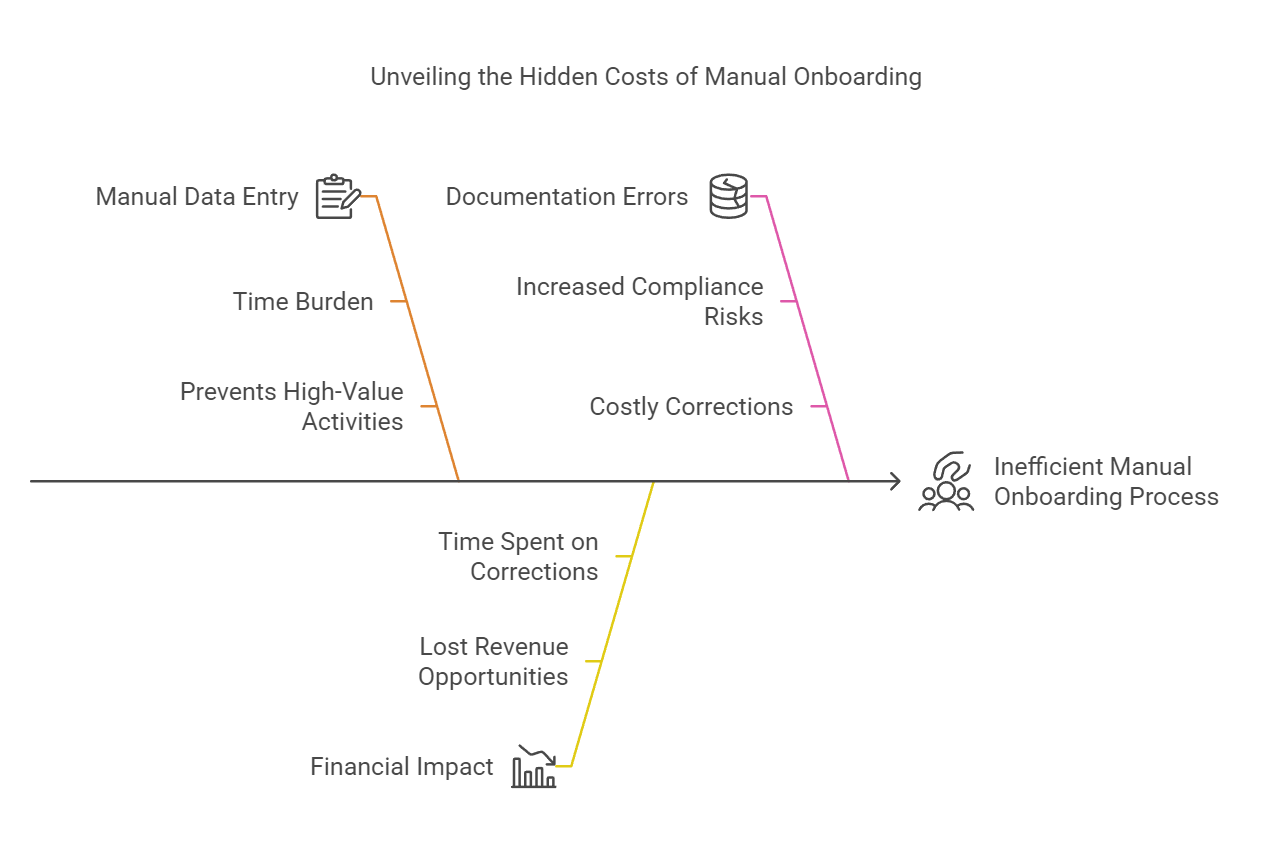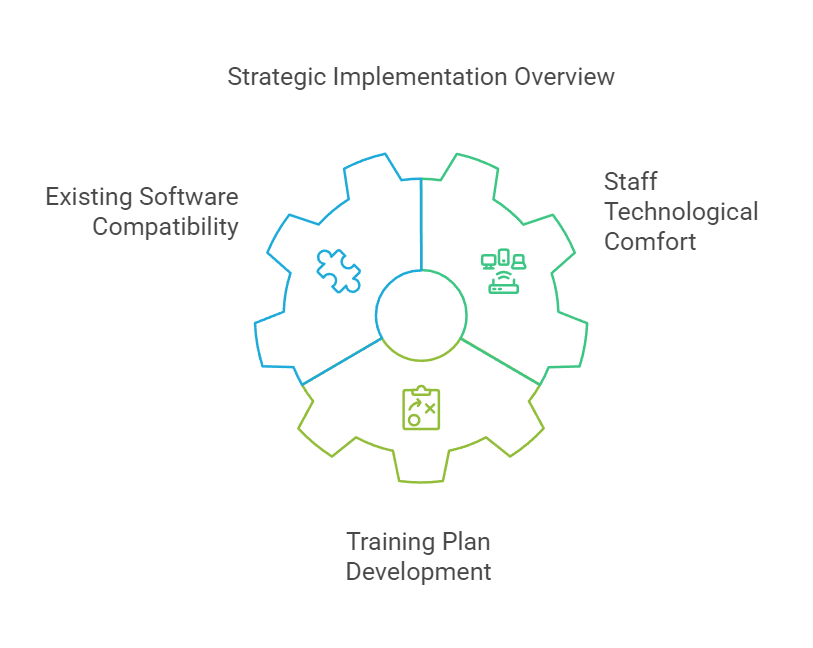
Article at a Glance:
• Manual resident onboarding creates significant operational inefficiencies, costing properties valuable time and resources while potentially impacting resident satisfaction and retention rates
• Modern resident retention platforms offer comprehensive solutions beyond basic automation, including centralized data management, real-time tracking, and enhanced communication capabilities
• Successful implementation requires careful evaluation of existing systems, staff capabilities, and operational needs, along with development of standardized workflows and quality control measures
• Digital transformation delivers measurable ROI through reduced processing times, fewer documentation errors, and improved resident satisfaction, while enabling staff to focus on high-value resident interactions
• Future-proofing requires ongoing platform optimization, robust risk management strategies, and careful attention to emerging technology trends and compliance requirements
This comprehensive guide explores how property managers can transform their onboarding processes through digital solutions, balancing operational efficiency with exceptional resident experiences while managing implementation challenges and maximizing long-term value.
Picture a typical afternoon in your leasing office: A stack of paperwork awaits processing, new residents shuffle impatiently in the lobby, and your staff juggles data entry with responding to urgent maintenance requests. This daily reality of manual resident onboarding isn't just inefficient—it's costing your properties valuable time, resources, and potentially residents themselves.
The link between smooth move-in experiences and resident retention presents a clear opportunity: by streamlining your onboarding process through a resident retention platform, you can significantly impact your property's bottom line while reducing administrative burden on your team.
The Hidden Costs of Manual Onboarding

Your property management team faces mounting pressure to deliver exceptional move-in experiences while managing ever-increasing administrative workloads. The current manual approach creates a ripple effect of challenges that extend far beyond move-in day:
• Manual data entry creates a significant time burden that varies based on your property type, number of residents per unit, and complexity of your documentation requirements. This administrative workload prevents your staff from focusing on high-value activities like resident engagement and property improvements.
• The financial impact manifests in several ways: Lost revenue opportunities stem from delayed move-ins and administrative bottlenecks, particularly during peak seasons. Your staff spends precious time correcting historical data instead of generating new leads or nurturing existing resident relationships.
• Documentation errors increase compliance risks and can lead to costly corrections down the line. Additionally, the resources spent on repetitive tasks inflate administrative costs while providing no added value to your residents or properties.
Digital Solutions: Beyond Basic Automation

Modern resident retention platforms offer capabilities beyond paperless processes. These solutions aim to integrate with property management software while offering enhanced features:
• Centralized data management eliminates redundant entry and maintains accuracy across systems. Through API connections, information can flow between platforms, though the effectiveness depends on the specific capabilities of both your existing software and the new platform.
• Real-time tracking capabilities give your team visibility into each resident's progress through the move-in process. This transparency helps enable proactive problem-solving and monitoring of critical steps during onboarding.
For your staff, potential benefits include:
• Reduced time spent on administrative tasks
• Fewer errors requiring correction
• More opportunities for meaningful resident interaction
• Improved ability to handle peak moving seasons
• Enhanced visibility into process bottlenecks
Strategic Implementation for Property Managers

Successful adoption of a resident retention platform requires careful planning that considers your property's unique needs and operational structure. Before selecting a platform, evaluate your current processes and identify specific pain points affecting your team's efficiency.
Assessing Readiness and Planning Implementation
Start by examining your property's current technological infrastructure and staff capabilities. Consider these key factors:
• Existing property management software forms the backbone of your operations. Any new platform should be thoroughly evaluated for compatibility with these systems. Review your current software's API capabilities, data structure, and integration requirements to understand potential challenges and limitations.
• Staff comfort with technology varies widely across properties. Some team members may require additional support during the transition, while others can serve as internal champions for the new system. Create a comprehensive training plan that addresses different skill levels and learning styles.
Implementation timelines vary significantly based on several key factors:
• Platform complexity and customization needs
• Staff size and training requirements
• Current technology infrastructure
• Number of properties in your portfolio
• Degree of process customization needed
• Integration requirements with existing systems
Creating Standardized Workflows
Consistency across properties helps ensure reliable service delivery and simplifies training requirements. Develop standardized processes that:
• Your team can follow during peak periods and staff changes. Document each step of the onboarding process, from initial application to move-in day, creating clear guidelines for handling common scenarios and exceptions.
• Build quality control checkpoints into your workflows to catch potential issues before they impact residents. These checkpoints help maintain high service standards while reducing the need for costly corrections later.
Measuring Impact and Performance
Track specific metrics to understand the impact of your digital transformation:
• Processing time for move-in documentation provides a clear before-and-after comparison. Monitor how quickly your team completes onboarding tasks and identify areas for optimization.
• Error rates in resident documentation highlight accuracy changes achieved through automation. Track both the frequency and type of errors to guide ongoing training and process refinement.
• Resident satisfaction scores during the move-in period offer direct feedback on your onboarding process. Use this data to make targeted improvements that enhance the resident experience.
Optimizing the Move-in Experience

A streamlined move-in process delivers value beyond operational efficiency—it sets the tone for the entire resident relationship. Digital platforms can transform traditional paperwork-heavy processes into more efficient experiences.
Digital Documentation Management
Transform your document handling process through electronic systems designed to maintain security while improving accessibility. Automated validation checks help ensure required fields are complete, helping reduce common errors that delay move-ins.
• Digital storage creates a searchable archive of resident documentation, helping simplify compliance checks and audits. Version control features track changes and maintain records of interactions, supporting both property and resident documentation needs.
Communication Automation
Effective resident communication begins before move-in day and continues through the entire onboarding process. Consider setting up welcome sequences that provide new residents with essential information at specific intervals. These automated touchpoints can help maintain consistent communication while reducing staff workload.
• Multiple communication channels accommodate resident preferences while working to maintain message consistency. Track engagement to identify which methods prove most effective for different types of communications.
Tracking and Visibility
Digital dashboards can provide visibility into each resident's progress through the move-in process. This transparency enables your team to:
• Track task completion and identify potential bottlenecks before they cause delays. Address issues proactively rather than waiting for resident complaints.
• Monitor overall process efficiency and make data-driven decisions about resource allocation during peak periods.
Maximizing ROI Through Continuous Improvement
Success with your resident retention platform requires ongoing attention to optimization and performance monitoring. Regular analysis helps identify opportunities for further efficiency gains and service improvements.
Data-Driven Decision Making
Modern platforms provide analytics capabilities that can inform process improvements:
• Track trends across properties to identify effective practices and areas needing attention. Compare performance metrics between locations to understand what drives success.
• Use data analysis to anticipate busy periods and adjust staffing accordingly. This proactive approach helps maintain service quality during peak times.
Future-Proofing Your Property Operations
As property management technology continues evolving, staying informed about industry trends helps protect your investment and maintain competitive advantage. Consider these forward-looking aspects when planning your digital transformation.
Emerging Technology Considerations
Your digital platform should be evaluated for its ability to accommodate new technologies and changing resident expectations. Consider solutions that offer regular updates and feature expansions to address evolving needs.
• Integration capabilities become increasingly important as new property management tools emerge. Evaluate platforms based on their architecture and ability to adapt to technological advances.
Risk Management and Compliance
Digital transformation introduces important considerations for risk management and security. Carefully review your insurance coverage to ensure it adequately addresses the specific risks associated with digital platforms, including:
• Data breaches and cybersecurity incidents
• System downtime and technology failures
• Privacy violations and compliance issues
• Integration-related disruptions
• Data loss or corruption events
Work with insurance professionals who specialize in cyber liability and technology risks to understand coverage needs. Consider how digital systems might introduce new vulnerabilities requiring specific protection.
Stay current with privacy regulations by evaluating platforms' security features and compliance updates. Build flexibility into your processes to accommodate evolving regulatory requirements.
Essential Questions to Consider
Before implementing a digital onboarding solution, address these critical considerations:
Integration and Implementation
Your existing software ecosystem requires thorough evaluation during platform selection. What are the specific integration capabilities and limitations of your current property management software? What data migration challenges might you encounter?
Consider both immediate and long-term costs, including:
• Initial platform investment
• Ongoing maintenance requirements
• Staff training needs
• Potential temporary productivity dips
• Resources needed for change management
• Cybersecurity and compliance measures
• Insurance coverage adjustments
Cross-Departmental Impact
Success requires coordination across your entire property management team. How will new processes affect:
• Leasing operations
• Maintenance scheduling
• Accounting procedures
• Management reporting
• Team communication protocols
Conclusion
The shift from manual to digital onboarding represents a significant change in property management operations. By implementing appropriate platforms and processes with careful consideration of risks and requirements, you can work toward more efficient operations that enhance both staff productivity and resident satisfaction.
Success in modern property management requires balancing operational efficiency with exceptional resident experiences. Digital platforms can help bridge this gap by automating routine tasks while enabling your team to focus on meaningful resident interactions.
Through careful planning, systematic implementation, and ongoing optimization, you can work to transform your property's onboarding process into a strategic advantage that supports long-term success.
Frequently Asked Questions (FAQs)
Q: How do retention platforms integrate with existing property management software?
A: Integration processes vary significantly between platforms and existing systems. Most platforms use API connections and data protocols to connect with current systems, though the complexity and effectiveness depend on factors like software compatibility, data structure alignment, and technical requirements. Work closely with vendors to understand specific integration capabilities and potential challenges.
Q: What should we expect for implementation timeline across multiple properties?
A: Implementation timelines vary based on your specific situation. Key factors affecting the timeline include your portfolio size, platform complexity, degree of customization needed, staff training requirements, and existing technology infrastructure. Work with your chosen vendor to develop a detailed implementation plan tailored to your needs.
Q: How can we measure the ROI of our platform investment?
A: Track both direct cost savings (reduced administrative time, lower paper costs, fewer errors) and indirect benefits (improved resident satisfaction, higher retention rates, increased staff productivity). Monitor these metrics over 12-24 months for a comprehensive view of platform value.
Q: What level of technical expertise does our staff need?
A: Most platforms are designed for users with basic computer skills. Look for solutions offering comprehensive training programs and ongoing support. Your team should be comfortable with basic digital tools and prepared to learn new processes.
Frequently Unasked Questions (FUQs)
Q: How might changing privacy regulations affect digital onboarding?
A: Privacy requirements continue to evolve, particularly regarding personal data protection. Choose platforms that demonstrate strong commitment to security and compliance updates. Build flexibility into your processes to adapt to new regulations, and maintain regular consultation with privacy experts.
Q: What hidden operational costs should we consider?
A: Beyond the platform investment, consider ongoing costs including staff training, system maintenance, security updates, customization needs, enhanced insurance coverage, and potential cybersecurity measures. Factor in temporary productivity adjustments during implementation and resources needed for change management.
Q: How does automated onboarding affect our insurance requirements?
A: Digital platforms introduce specific risks requiring careful insurance consideration. Work with insurance professionals who understand both property management and technology risks. Review and potentially update coverage for areas including cyber liability, data protection, business interruption, and professional liability.
Q: What cross-departmental changes should we prepare for?
A: Success requires coordination across leasing, maintenance, accounting, and management teams. Consider impacts on existing workflows, communication protocols, and reporting requirements. Plan for adequate training and support across all affected departments.
Q: How can we maintain personal connection while automating processes?
A: Focus automation on administrative tasks while preserving human interaction for relationship-building moments. Use the time saved through automation to enhance face-to-face resident engagement during critical touchpoints. Regularly assess which processes benefit from automation versus personal attention.
Ready to Transform Your Resident Onboarding Experience?
ElevateOS's resident retention platform helps property managers streamline operations, boost resident satisfaction, and reduce turnover through automated workflows and enhanced communication tools. Our solution integrates seamlessly with your existing systems to create a more efficient, engaging resident experience from day one.
Take the first step toward modernizing your property operations. Request a demo today to see how ElevateOS can help you:
• Streamline your resident onboarding process
• Reduce administrative workload
• Enhance resident communication
• Minimize turnover and vacancy rates
• Improve overall resident satisfaction
Connect with us on social media to stay updated on property management insights and industry trends:
• LinkedIn: Follow us on LinkedIn
• Facebook: Join our Facebook community
• Instagram: Connect with us on Instagram

.avif)


